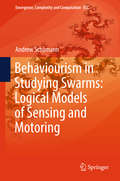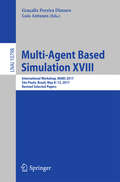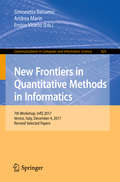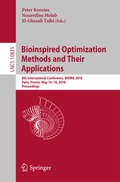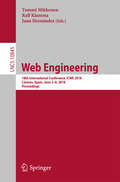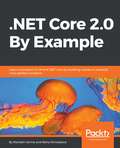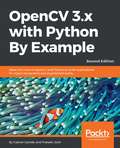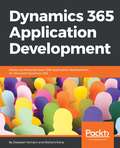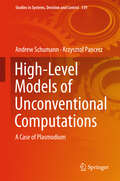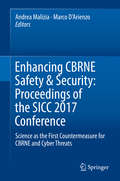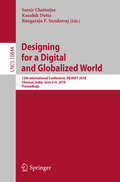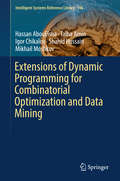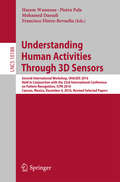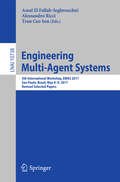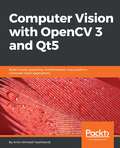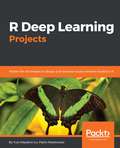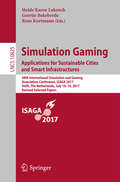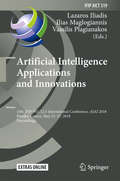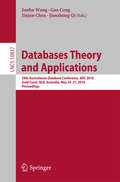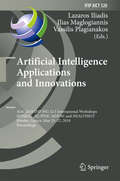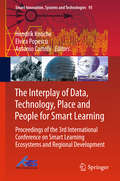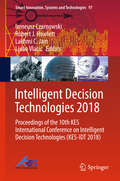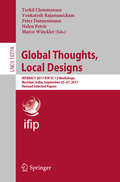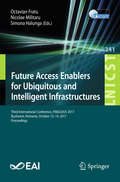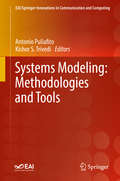- Table View
- List View
Behaviourism in Studying Swarms: Logical Models of Sensing and Motoring (Emergence, Complexity And Computation Ser. #33)
by Andrew SchumannThis book presents fundamental theoretical results for designing object-oriented programming languages for controlling swarms. It studies the logics of swarm behaviours. According to behaviourism, all behaviours can be controlled or even managed by stimuli in the environment: attractants (motivational reinforcement) and repellents (motivational punishment). At the same time, there are two main stages in reactions to stimuli: sensing (perceiving signals) and motoring (appropriate direct reactions to signals). This book examines the strict limits of behaviourism from the point of view of symbolic logic and algebraic mathematics: how far can animal behaviours be controlled by the topology of stimuli? On the one hand, we can try to design reversible logic gates in which the number of inputs is the same as the number of outputs. In this case, the behaviouristic stimuli are inputs in swarm computing and appropriate reactions at the motoring stage are its outputs. On the other hand, the problem is that even at the sensing stage each unicellular organism can be regarded as a logic gate in which the number of outputs (means of perceiving signals) greatly exceeds the number of inputs (signals).
Multi-Agent Based Simulation XVIII: International Workshop, Mabs 2017, São, Brazil, May 8-12. 2017, Revised Selected Papers (Lecture Notes in Computer Science #10798)
by Luis Antunes Graçaliz Pereira DimuroThis book constitutes the thoroughly refereed post-conference proceedings of the 18th International Workshop on Multi-Agent-Based Simulation, MABS 2017, held in Sao Paulo, Brazil, in May 2017. The workshop was held in conjunction with the 16th International Conference on Autonomous Agents and Multi-Agent Systems, AAMAS 2017. The 15 revised full papers included in this volume were carefully selected from 23 submissions. The topic of the papers is about applying agent-based simulation techniques to real-world problems focusing on the confluence of socio-technical-natural sciences and multi-agent systems with a strong application/empirical vein.
New Frontiers in Quantitative Methods in Informatics: 7th Workshop, Infq 2017, Venice, Italy, December 4, 2017, Revised Selected Papers (Communications In Computer And Information Science #825)
by Enrico Vicario Andrea Marin Simonetta BalsamoThis book constitutes the refereed proceedings of the 7th Workshop on New Frontiers in Quantitative Methods in Informatics, InfQ 2017, held in Venice, Italy, in December 2017.The 11 revised full papers and the one revised short paper presented were carefully reviewed and selected from 22 submissions. The papers are organized in topical sections on networking and mobile applications; applications of quantitative modeling; big data processing and IoT; theory, methods and tools for quantitative analysis.
Bioinspired Optimization Methods and Their Applications: 8th International Conference, Bioma 2018, Paris, France, May 16-18, 2018, Proceedings (Lecture Notes in Computer Science #10835)
by El-Ghazali Talbi Nouredine Melab Peter KorošecThis book constitutes the thoroughly refereed revised selected papers of the 10th International Conference on Bioinspired Optimization Models and Their Applications, BIOMA 2018, held in Paris, France, in May 2018. The 27 revised full papers were selected from 53 submissions and present papers in all aspects of bioinspired optimization research such as new algorithmic developments, high-impact applications, new research challenges, theoretical contributions, implementation issues, and experimental studies.
Web Engineering: 18th International Conference, Icwe 2018, Cáceres, Spain, June 5-8, 2018, Proceedings (Theoretical Computer Science and General Issues #10845)
by Juan Hernández Ralf Klamma Tommi MikkonenThis book constitutes the refereed proceedings of the 18th International Conference on Web Engineering, ICWE 2018, held in Cáceres, Spain, in June 2018.The 18 full research papers and 17 short papers presented together with 2 practice papers, 6 demonstration papers, and 5 tutorials were carefully reviewed and selected from 103 submissions. The papers cover research areas such as Web application modeling and engineering; Web infrastructures and architectures; execution models; human computation and crowdsourcing applications; Web application composition and mashups; Social Web applications; Semantic Web applications; Web of Things applications; big data and data analytics; and security, privacy, and identity.
.NET Core 2.0 By Example: Learn to program in C# and .NET Core by building a series of practical, cross-platform projects
by Neha Shrivastava Rishabh VermaBuild cross-platform solutions with .NET Core 2.0 through real-life scenariosKey Features Bridges the gap between learning and doing and improves your software development skills Covers the best practices of .NET development to improve your productivity Example-based approach to get you started quickly with software programmingBook DescriptionWith the rise in the number of tools and technologies available today, developers and architects are always exploring ways to create better and smarter solutions. Before, the differences between target platforms was a major roadblock, but that's not the case now. .NET Core 2.0 By Example will take you on an exciting journey to building better software.This book provides fresh and relevant content to .NET Core 2.0 in a succinct format that’s enjoyable to read. It also delivers concepts, along with the implications, design decisions, and potential pitfalls you might face when targeting Linux and Windows systems, in a logical and simple way.With the .NET framework at its center, the book comprises of five varied projects: a multiplayer Tic-tac-toe game; a real-time chat application, Let'sChat; a chatbot; a microservice-based buying-selling application; and a movie booking application. You will start each chapter with a high-level overview of the content, followed by the above example applications described in detail. By the end of each chapter, you will not only be proficient with the concepts, but you’ll also have created a tangible component in the application.By the end of the book, you will have built five solid projects using all the tools and support provided by the .NET Core 2.0 framework.What you will learn Build cross-platform applications with ASP.NET Core 2.0 and its tools Integrate, host, and deploy web apps with the cloud (Microsoft Azure) Leverage the ncurses native library to extend console capabilities in .NET Core on Linux and interop with native coden .NET Core on Linux and learn how to interop with existing native code Reuse existing .NET Framework and Mono assemblies from .NET Core 2.0 applications Develop real-time web applications using ASP.NET Core Learn the differences between SOA and microservices and get started with microservice development using ASP.NET Core 2.0 Walk through functional programming with F# and .NET Core from scratchWho this book is forIf you are a developer or architect and want to learn how to build cross-platform solutions using Microsoft .NET Core, this book is for you. It is assumed that you have some knowledge of the .NET Framework, OOP, and C# (or a similar programming language).
OpenCV 3.x with Python By Example: Make the most of OpenCV and Python to build applications for object recognition and augmented reality
by Gabriel Garrido Calvo Naren Yellavula Prateek JoshiLearn the techniques for object recognition, 3D reconstruction, stereo imaging, and other computer vision applications using examples on different functions of OpenCV. Key Features Learn how to apply complex visual effects to images with OpenCV 3.x and Python Extract features from an image and use them to develop advanced applications Build algorithms to help you understand image content and perform visual searches Get to grips with advanced techniques in OpenCV such as machine learning, artificial neural network, 3D reconstruction, and augmented reality Book Description Computer vision is found everywhere in modern technology. OpenCV for Python enables us to run computer vision algorithms in real time. With the advent of powerful machines, we have more processing power to work with. Using this technology, we can seamlessly integrate our computer vision applications into the cloud. Focusing on OpenCV 3.x and Python 3.6, this book will walk you through all the building blocks needed to build amazing computer vision applications with ease. We start off by manipulating images using simple filtering and geometric transformations. We then discuss affine and projective transformations and see how we can use them to apply cool advanced manipulations to your photos like resizing them while keeping the content intact or smoothly removing undesired elements. We will then cover techniques of object tracking, body part recognition, and object recognition using advanced techniques of machine learning such as artificial neural network. 3D reconstruction and augmented reality techniques are also included. The book covers popular OpenCV libraries with the help of examples. This book is a practical tutorial that covers various examples at different levels, teaching you about the different functions of OpenCV and their actual implementation. By the end of this book, you will have acquired the skills to use OpenCV and Python to develop real-world computer vision applications. What you will learn Detect shapes and edges from images and videos How to apply filters on images and videos Use different techniques to manipulate and improve images Extract and manipulate particular parts of images and videos Track objects or colors from videos Recognize specific object or faces from images and videos How to create Augmented Reality applications Apply artificial neural networks and machine learning to improve object recognitionWho this book is for This book is intended for Python developers who are new to OpenCV and want to develop computer vision applications with OpenCV and Python. This book is also useful for generic software developers who want to deploy computer vision applications on the cloud. It would be helpful to have some familiarity with basic mathematical concepts such as vectors, matrices, and so on.
Dynamics 365 Application Development: Master professional-level CRM application development for Microsoft Dynamics 365
by Deepesh Somani Nishant RanaLearn, develop, and design applications using the new features in Microsoft Dynamics CRM Key Features - Implement business logic using processes, plugins, and client-side scripts with MS Dynamics 365 - Develop custom CRM solutions to improve your business applications - A comprehensive guide that covers the new features of Microsoft Dynamics 365 and increasingly advanced topics. Book Description Microsoft Dynamics 365 CRM is the most trusted name in enterprise-level customer relationship management. Thelatest version of Dynamics CRM comes with the important addition of exciting features guaranteed to make your life easier. It comes straight off the shelf with a whole new frontier of updated business rules, process enhancements, SDK methods, and other enhancements. This book will introduce you to the components of the new designer tools, such as SiteMap, App Module, and Visual Designer for Business Processes. Going deeper, this book teaches you how to develop custom SaaS applications leveraging the features of PowerApps available in Dynamics 365.Further, you will learn how to automate business processes using Microsoft Flow, and then we explore Web API, the most important platform update in Dynamics 365 CRM. Here, you'll also learn how to implement Web API in custom applications. You will learn how to write an Azure-aware plugin to design and integrate cloud-aware solutions. The book concludes with configuring services using newly released features such as Editable grids, Data Export Service, LinkedIn Integration, Relationship Insights, and Live Assist. What you will learn - Discover new designers tools included in Dynamics 365 CRM - Develop apps using the platform-agnostic Web API - Leverage Azure Extensions to design cloud-aware applications - Learn how to implement CRUD operation - Create integrated real-world apps using Microsoft PowerApps and Flow by combining services such as Twitter, Facebook, and SharePoint - Configure and use Artificial Intelligence Azure Cognitive Services for Recommendation and Text Analytic servicesWho this book is for This book targets skilled developers who are looking to build business-solution software and are new to application development in Microsoft Dynamics 365, especially for CRM.
High-Level Models of Unconventional Computations: A Case Of Plasmodium (Studies in Systems, Decision and Control #159)
by Krzysztof Pancerz Andrew SchumannThis book shows that the plasmodium of Physarum polycephalum can be considered a natural labelled transition system, and based on this, it proposes high-level programming models for controlling the plasmodium behaviour. The presented programming is a form of pure behaviourism: the authors consider the possibility of simulating all basic stimulus–reaction relations. As plasmodium is a good experimental medium for behaviouristic models, the book applies the programming tools for modelling plasmodia as unconventional computers in different behavioural sciences based on studying the stimulus–reaction relations. The authors examine these relations within the framework of a bio-inspired game theory on plasmodia they have developed i.e. within an experimental game theory, where, on the one hand, all basic definitions are verified in experiments with Physarum polycephalum and Badhamia utricularis and, on the other hand, all basic algorithms are implemented in the object-oriented language for simulations of plasmodia. The results allow the authors to propose that the plasmodium can be a model for concurrent games and context-based games.
Enhancing CBRNE Safety & Security: Science As The First Countermeasure For Cbrne And Cyber Threats
by Marco D’Arienzo Andrea MaliziaThis book presents the proceedings of SICC 2017, a conference devoted to promoting the dissemination of the different methodologies, techniques, theories, strategies, technologies and best practices on the prevention and mitigation of CBRNE risks. As the first scientific international conference on safety & security issues in the CBRNE field, SICC 2017 attracted contributions resulting from fruitful inter-professional collaborations between university and military experts, specialized operators, decision makers and the industry. As such, these proceedings are primarily intended for academics and professionals from public, private and military entities. It is the first trans-disciplinary collection of scientific papers from the numerous fields related to CBRNE.
Designing for a Digital and Globalized World: 13th International Conference, Desrist 2018, Chennai, India, June 3-6, 2018, Proceedings (Theoretical Computer Science and General Issues #10844)
by Rangaraja P. Sundarraj Kaushik Dutta Samir ChatterjeeThis book constitutes the proceedings of the 13th International Conference on Design Science Research in Information Systems and Technology, DESRIST 2018, held in June 2018 in Chennai, India. The 24 full papers presented in this volume were carefully reviewed and selected from 96 papers. The contributions are organized in topical sections named: HCI and Design, Design Foundations, Design Foundations, Design in Healthcare, Advances in Data Science and Analytics, ICT for Development, Designing Cybersecurity, and Design Applications.
Extensions of Dynamic Programming for Combinatorial Optimization and Data Mining (Intelligent Systems Reference Library #146)
by Mikhail Moshkov Shahid Hussain Igor Chikalov Talha Amin Hassan AbouEishaDynamic programming is an efficient technique for solving optimization problems. It is based on breaking the initial problem down into simpler ones and solving these sub-problems, beginning with the simplest ones. A conventional dynamic programming algorithm returns an optimal object from a given set of objects. This book develops extensions of dynamic programming, enabling us to (i) describe the set of objects under consideration; (ii) perform a multi-stage optimization of objects relative to different criteria; (iii) count the number of optimal objects; (iv) find the set of Pareto optimal points for bi-criteria optimization problems; and (v) to study relationships between two criteria. It considers various applications, including optimization of decision trees and decision rule systems as algorithms for problem solving, as ways for knowledge representation, and as classifiers; optimization of element partition trees for rectangular meshes, which are used in finite element methods for solving PDEs; and multi-stage optimization for such classic combinatorial optimization problems as matrix chain multiplication, binary search trees, global sequence alignment, and shortest paths. The results presented are useful for researchers in combinatorial optimization, data mining, knowledge discovery, machine learning, and finite element methods, especially those working in rough set theory, test theory, logical analysis of data, and PDE solvers. This book can be used as the basis for graduate courses.
Understanding Human Activities Through 3D Sensors: Second International Workshop, Uha3ds 2016, Held In Conjunction With The 23rd International Conference On Pattern Recognition, Icpr 2016, Cancun, Mexico, December 4, 2016, Revised Selected Papers (Theoretical Computer Science and General Issues #10188)
by Francisco Flórez-Revuelta Mohamed Daoudi Pietro Pala Hazem WannousThis book constitutes the revised selected papers of the Second International Workshop on Understanding Human Activities through 3D Sensors, UHA3DS 2016, that was held in conjunction with the 23rd International Conference on Pattern Recognition, ICPR 2016, held in Cancun, Mexico, in December 2016. The 9 revised full papers were carefully reviewed and selected from 12 submissions. The papers are organized in topical sections on Behavior Analysis, Human Motion Recognition, and Application Datasets.
Engineering Multi-Agent Systems: First International Workshop, Emas 2013, St. Paul, Mn, Usa, May 6-7, 2013, Revised Selected Papers (Theoretical Computer Science and General Issues #8245)
by Tran Cao Son Alessandro Ricci Amal El Fallah-SeghrouchniThis book constitutes the revised and selected papers from the 5th International Workshop on Engineering Multi-Agent Systems held in Sao Paulo, Brazil, in May 2018, in conjunction with AAMAS 2018. The 11 full papers presented in this volume were carefully reviewed and selected from 18 submissions. The book contains also the best paper of the workshop that has been published previously in another LNCS volume. The EMAS workshop focusses on the cross-fertilisation of ideas and experiences in the various fields with the aim to enhance knowledge and expertise in MAS engineering , to improve the state-of-the-art, to define new directions for MAS engineering, to investigate how established methodologies for engineering and large-scale and open MAS can be adapted.
Computer Vision with OpenCV 3 and Qt5: Build visually appealing, multithreaded, cross-platform computer vision applications
by Amin Ahmadi Tazehkandi Karl Phillip Buhr Vinícius GodoyKey Features ● Start creating robust applications with the power of OpenCV and Qt combined ● Learn from scratch how to develop cross-platform computer vision applications ● Accentuate your OpenCV applications by developing them with Qt Book Description Developers have been using OpenCV library to develop computer vision applications for a long time. However, they now need a more effective tool to get the job done and in a much better and modern way. Qt is one of the major frameworks available for this task at the moment. This book will teach you to develop applications with the combination of OpenCV 3 and Qt5. This book will teach you to create cross-platform computer vision applications. We’ll begin by introducing Qt, its IDE, and its SDK. Next you’ll learn how to use the OpenCV API to integrate both tools, and see how to configure Qt to use OpenCV. You’ll go on to build a full-fledged computer vision application throughout the book. Later, you’ll create a stunning UI application using the Qt widgets technology, where you’ll display the images after they are processed in an efficient way. At the end of the book, you’ll learn how to convert OpenCV Mat to Qt QImage. You’ll also see how to efficiently process images to filter them, transform them, detect or track objects as well as analyze video. You’ll become better at developing OpenCV applications. What you will learn ● Get an introduction to Qt IDE and SDK ● Be introduced to OpenCV and see how to communicate between OpenCV and Qt ● Understand how to create UI using Qt Widgets ● Know to develop cross-platform applications using OpenCV 3 and Qt 5 ● Explore the multithreaded application development features of Qt5 ● Improve OpenCV 3 application development using Qt5 ● Build, test, and deploy Qt and OpenCV apps, either dynamically or statically ● See Computer Vision technologies such as filtering and transformation of images, detecting and matching objects, template matching, object tracking, video and motion analysis, and much more ● Be introduced to QML and Qt Quick for iOS and Android application development
R Deep Learning Projects: Master the techniques to design and develop neural network models in R
by Yuxi Hayden Liu Pablo Maldonado5 real-world projects to help you master deep learning concepts Key Features Master the different deep learning paradigms and build real-world projects related to text generation, sentiment analysis, fraud detection, and more Get to grips with R's impressive range of Deep Learning libraries and frameworks such as deepnet, MXNetR, Tensorflow, H2O, Keras, and text2vec Practical projects that show you how to implement different neural networks with helpful tips, tricks, and best practices Book Description R is a popular programming language used by statisticians and mathematicians for statistical analysis, and is popularly used for deep learning. Deep Learning, as we all know, is one of the trending topics today, and is finding practical applications in a lot of domains. This book demonstrates end-to-end implementations of five real-world projects on popular topics in deep learning such as handwritten digit recognition, traffic light detection, fraud detection, text generation, and sentiment analysis. You'll learn how to train effective neural networks in R—including convolutional neural networks, recurrent neural networks, and LSTMs—and apply them in practical scenarios. The book also highlights how neural networks can be trained using GPU capabilities. You will use popular R libraries and packages—such as MXNetR, H2O, deepnet, and more—to implement the projects. By the end of this book, you will have a better understanding of deep learning concepts and techniques and how to use them in a practical setting. What you will learn - Instrument Deep Learning models with packages such as deepnet, MXNetR, Tensorflow, H2O, Keras, and text2vec - Apply neural networks to perform handwritten digit recognition using MXNet - Get the knack of CNN models, Neural Network API, Keras, and TensorFlow for traffic sign classification -Implement credit card fraud detection with Autoencoders -Master reconstructing images using variational autoencoders - Wade through sentiment analysis from movie reviews - Run from past to future and vice versa with bidirectional Long Short-Term Memory (LSTM) networks - Understand the applications of Autoencoder Neural Networks in clustering and dimensionality reductionWho this book is for Machine learning professionals and data scientists looking to master deep learning by implementing practical projects in R will find this book a useful resource. A knowledge of R programming and the basic concepts of deep learning is required to get the best out of this book.
Simulation Gaming. Applications for Sustainable Cities and Smart Infrastructures: 48th International Simulation And Gaming Association Conference, Isaga 2017, Delft, The Netherlands, July 10-14, 2017, Revised Selected Papers (Theoretical Computer Science and General Issues #10825)
by Rens Kortmann Geertje Bekebrede Heide Karen LukoschThis book constitutes the refereed post-conference proceedings of the 48th International Simulation and Gaming Association Conference, ISAGA 2018, held in Delft, The Netherlands, in July 2018. The 19 revised full papers included in the volume were carefully reviewed and selected from 27 submissions. The contributions to this book range from design thinking related to simulation gaming, the analysis of the consequences of design choices in games, to games for decision making, examples of games for business, climate change, maritime spatial planning, sustainable city development, supply chain, and much more.
Artificial Intelligence Applications and Innovations: Aiai 2018 Ifip Wg 12. 5 International Workshops, Sedseal, 5g-pine, Mhdw, And Healthiot, Rhodes, Greece, May 25-27, 2018, Proceedings (IFIP Advances in Information and Communication Technology #520)
by Vassilis Plagianakos Ilias Maglogiannis Lazaros IliadisThis book constitutes the refereed proceedings of the 14th IFIP WG 12.5 International Conference on Artificial Intelligence Applications and Innovations, AIAI 2018, held in Rhodes, Greece, in May 2018.The 42 full papers and 12 short papers were carefully reviewed and selected from 88 submissions. They are organized in the following topical sections: social media, games, ontologies; deep learning; support vector machines; constraints; machine learning, regression, classification; neural networks; medical intelligence; recommender systems; optimization; learning, intelligence; heuristic approaches, cloud; fuzzy; and human and computer interaction, sound, video, processing.
Databases Theory and Applications: 26th Australasian Database Conference, Adc 2015, Melbourne, Vic, Australia, June 4-7, 2015. Proceedings (Theoretical Computer Science and General Issues #9093)
by Jianzhong Qi Jinjun Chen Gao Cong Junhu WangThis book constitutes the refereed proceedings of the 29th Australasian Database Conference, ADC 2018, held in Gold Coast, QLD, Australia, in May 2018.The 23 full papers plus 6 short papers presented together with 3 demo papers were carefully reviewed and selected from 53 submissions. The Australasian Database Conference is an annual international forum for sharing the latest research advancements and novel applications of database systems, data-driven applications, and data analytics between researchers and practitioners from around the globe, particularly Australia and New Zealand.
Artificial Intelligence Applications and Innovations: Aiai 2018 Ifip Wg 12. 5 International Workshops, Sedseal, 5g-pine, Mhdw, And Healthiot, Rhodes, Greece, May 25-27, 2018, Proceedings (IFIP Advances in Information and Communication Technology #520)
by Vassilis Plagianakos Ilias Maglogiannis Lazaros IliadisThis book constitutes the refereed proceedings of 4 workshops held at the 14th IFIP WG 12.5 International Conference on Artificial Intelligence Applications and Innovations, AIAI 2018, held in Rhodes, Greece, in May 2018. The workshops were the Workshop on Semantics in the Deep: Semantic Analytics for Big Data, SEDSEAL 2018; the Third Workshop on 5G - Putting Intelligence to the Network Edge, 5G-PINE 2018; the 7th Mining Humanistic Data Workshop, MHDW 2018; and the Workshop on Intelligent Cloud and IOT Paradigms in EHealth, HEALTHIOT 2018.The 19 full papers and 5 short papers presented were carefully reviewed and selected from a total of 53 submissions: SEDSEAL accepted 2 full papers out of 5 submissions, 5G-PINE 6 full and one short paper out of 24, MHDW 7 full and 4 short papers out of 15, and HEALTHIOT 4 full papers out of 9. The papers cover topics such as AI in 5G and telecommunications, AI and e-health services, AI in 5G networks, incremental learning, clustering, AI in text mining, visual data analytics, AI in molecular biology, DNA, RNA, proteins, big data analytics, Internet of Things and recommender systems, and AI in biomedical applications.
The Interplay of Data, Technology, Place and People for Smart Learning: Proceedings Of The 3rd International Conference On Smart Learning Ecosystems And Regional Development (Smart Innovation, Systems And Technologies #95)
by Antonio Cartelli Elvira Popescu Hendrik KnocheThis book gathers contributions to the 3rd International Conference on Smart Learning Ecosystems and Regional Developments (SLERD 2018), held at Aalborg University, Denmark on 23–25 May 2018. What characterizes smart learning ecosystems? What is their role in city and regional development and innovation? How can we promote citizen engagement in smart learning ecosystems? These are some of the questions addressed at SLERD 2018 and documented in these proceedings, which include a diverse range of papers intended to help understand, conceive, and promote innovative human-centric design and development methods, education/training practices, informal social learning, and citizen-driven policies. The papers elaborate on the notion of smart learning ecosystems, assess the relation of smart learning ecosystems with their physical surroundings, and identify new resources for smart learning. SLERD 2018 contributes to foster the social innovation sectors, ICT and economic development and deployment strategies, as well as new policies for smarter, more proactive citizens. As such, these proceedings are relevant for researchers and policymakers alike.
Intelligent Decision Technologies 2018: Proceedings Of The 10th Kes International Conference On Intelligent Decision Technologies (kes-idt 2018) (Smart Innovation, Systems And Technologies #97)
by Ljubo Vlacic Lakhmi C. Jain Robert J. Howlett Ireneusz CzarnowskiThis book gathers the proceedings of the KES-IDT-2018 conference, held in Gold Coast, Queensland, Australia, on June 20–22, 2018 The conference provided opportunities to present and discuss the latest research results, promoting knowledge transfer and the generation of new ideas in the field of intelligent decision-making. The range of topics explored is wide, and includes methods for decision-making, decision support, data analysis, modeling and many more in areas such as finance, economics, management, engineering and transportation. The book contains several sections devoted to specific topics, such as: · Decision-Making Theory for Economics · Advances in Knowledge-based Statistical Data Analysis · On Knowledge-Based Digital Ecosystems & Technologies for Smart and Intelligent Decision Support Systems · Soft Computing Models in Industrial and Management Engineering · Computational Media Computing and its Applications · Intelligent Decision-Making Technologies · Digital Architectures and Decision Management
Global Thoughts, Local Designs: Ifip Tc 13 Workshops At Interact 2017, Mumbai, India, September 25-27, 2017, Revised Selected Paperrs (Theoretical Computer Science and General Issues #10774)
by Marco Winckler Helen Petrie Peter Dannenmann Venkatesh Rajamanickam Torkil ClemmensenThis book contains revised selected papers presented at 4 workshops held at the 16th IFIP TC 13 International Conference on Human-Computer Interaction, INTERACT 2017, in Mumbai, India, in September 2017. The workshops are: Workshop on Dealing with Conflicting User Interface Properties in User-Centered Development Processes (IFIP WG 13.2 and 13.5), Workshop on Cross Cultural Differences in Designing for Accessibility and Universal Design Organizers (IFIP WG 13.3), Human Work Interaction Design Meets International Development (IFIP WG 13.6), and Beyond Computers: Wearables, Humans, and Things - WHAT! (IFIP WG 13.7).The 15 full papers included in this volume were carefully reviewed and selected from numerous submissions. They show advances in the field of HCI dealing with topics such as human-centered computing, user interface design, evolutionary user interface prototyping, end-user development systems, accessibility design, human work interaction design, and wearables.
Future Access Enablers for Ubiquitous and Intelligent Infrastructures: Third International Conference, Fabulous 2017, Bucharest, Romania, October 12-14, 2017, Proceedings (Lecture Notes of the Institute for Computer Sciences, Social Informatics and Telecommunications Engineering #241)
by Simona Halunga Nicolae Militaru Octavian FratuThis book constitutes the refereed post-conference proceedings of the Third International Conference on Future Access Enablers for Ubiquitous and Intelligent Infrastructures, FABULOUS 2017, held in Bucharest, Romania, in October 2017. The 37 revised full papers were carefully reviewed and selected from 61 submissions. The main topics deal with future access networks, Internet of Things and smart city/smart environment applications, communications and computing infrastructures, security aspects in communication and data processing, signal processing and multimedia.
Systems Modeling: Methodologies and Tools (EAI/Springer Innovations in Communication and Computing)
by Antonio Puliafito Kishor S. TrivediThis book covers ideas, methods, algorithms, and tools for the in-depth study of the performance and reliability of dependable fault-tolerant systems. The chapters identify the current challenges that designers and practitioners must confront to ensure the reliability, availability, and performance of systems, with special focus on their dynamic behaviors and dependencies. Topics include network calculus, workload and scheduling; simulation, sensitivity analysis and applications; queuing networks analysis; clouds, federations and big data; and tools. This collection of recent research exposes system researchers, performance analysts, and practitioners to a spectrum of issues so that they can address these challenges in their work.
